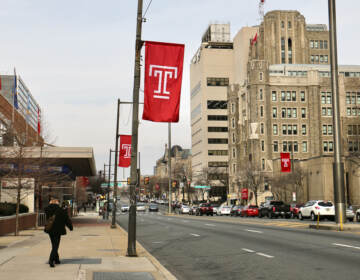Philadelphia in bloom – don’t miss the show
For people who like trees, April is the big show. In terms of nature’s performances, last month was the earnest community theater production, and this month is the star studded million dollar Broadway extravaganza. The curtains have risen, and we’re still in the first act of a great spectacle that will last for weeks with no intermission.
Magnificent magnolias
Every tree has its moment to shine, and the big saucer magnolias are having theirs right now. The smaller, more dainty star magnolias opened a week or two earlier, and this year (like so many other years) they got zapped by frost and quit before they started. But the generally cool weather we’re having is creating perfect conditions for the larger and more spectacular varieties.
Last spring the magnolia season lasted about 48 hours, as it coincided with the first of many 2010 heat waves. It seemed only a matter of hours between the unfurling of the large, pointy buds and their sudden collapse into a slippery brown layer of fermenting goo over sidewalks and backyards. This year they’ve been putting on an amazing pink show for over a week, and they look ready to go on for at least one more.
April showers, maple flowers
This week is also a good time to take a look at maples, which are flowering right now. Yes, the delicate shades of red, yellow, and chartreuse green covering the tips of the branches are flowers, not leaves. In a month the different maples will all look pretty much the same to most of us, as their other identifying characteristics are much more subtle. But right now they are completely distinct. The red flowering maples are, no surprise, red maples. The yellow are sugar maples, and the bright green clusters are found on Norway maples.
Many people are aware that the Norway maples are not considered the most desirable of species. They’re great in Norway and other really cold places, but the longer growing season here means that the trees grow overly long branches with too many, overly big leaves for the way they’re engineered. Norway maples are famous for splitting apart when they get big, which is a bummer since there are a lot of them planted as street trees in Philadelphia. These end up being the car crushers.
It’s too bad we can’t like them more; they have a great history. The first Norway maple seeds in America came right here to Philly in a box addressed to John Bartram in 1756. He began propagating them, and in 1792 George Washington ordered two Norway maples for his gardens at Mt. Vernon. Lauded for their hardiness and beauty, they were planted frequently into the 20th century before going out of favor for the reasons mentioned and because they take muscle out the native trees in woodland settings.
A pear tree mystery
April is also the month for the ubiquitous ornamental pear trees. These have to be among the most commonly planted of any street tree in the city, although they only make it about twenty years before breaking apart like those Norway maples. They are quite beautiful, their large canopies covered in thousands of clusters of white blossoms. Their virginal appearance is unfortunately not accompanied by a corresponding fragrance- last week I heard them referred to as “fish trees.”
Although 99 percent of the pear trees blooming are the same variety, ‘Bradford,’ there are a tiny number of other pear trees also in flower right now, and these speak to an interesting and almost lost tradition. In Philadelphia neighborhoods in which the houses were built before about the 1860s, there is occasionally still a very old pear tree standing sentinel just next to the back door. I have never come across a reference to this custom, and so far can’t find anyone who has also noticed it, but in the meantime I’ve been starting to document the locations of all the old dooryard pear trees I see.
“Those are pears I keep stepping on?” remarked a neighbor of one of the venerable trees I came across in Germantown. I understood his confusion. The fruit of these trees is small and somewhat primitive looking, but they are completely edible and quite delicious; in old catalogs they were categorized as either “butter” or “sugar” pears, depending on the variety. These trees, and the shred of history that still clings to them, are the last living records of a time when even city people had a much different relationship to the outdoors.
There’s so much to look forward to before the curtains of spring close again. Dogwoods will be out in the next few weeks, along with the redbuds and showy, later blossoming cherry trees. Lilacs! Wisteria! Forget Paris, I don’t think there is any prettier place than Philadelphia in the springtime.
The video above is a collaboration between Newsworks Ground Level blogger Nicole Juday and NewsWorks videographer Kimberly Paynter. It’s an initiative to both pay homage to springtime in Philadelphia, and to invite viewers to take a few moments and appreciate what’s unfurling around them.
WHYY is your source for fact-based, in-depth journalism and information. As a nonprofit organization, we rely on financial support from readers like you. Please give today.




